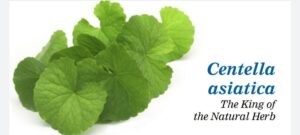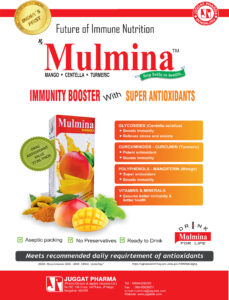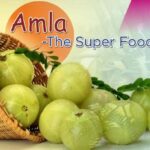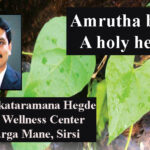How Centella Asiatica (Brahmi), the king of the natural herb is essential to our health?


Centella asiatica (CA) is a vital medicinal herb. Commonly known as Mandukaparni, Brahmi, Gotu Kola, Indian pennywort or Jalbrahmi. It has been used as a medicine in India in Ayurveda for thousands of years and mentioned in the momentous ‘Sushruta Samhita’, (an ancient Indian medical text). In 19th century, CA and its decoction were integrated into Indian pharmacopoeia.
Description of the plant: Centella asiatica, a clonal, perennial herbaceous creeper belonging to the family Umbellifere (Apiceae) is found throughout India growing in moist places up to an altitude of 1800 m. It is a tasteless, odourless plant that thrives in and around water. It has small fan-shaped green leaves with white or light purple-topink or white flowers and it bears small oval fruit.
Active constituents:
The primary active constituents of Centella asiatica are saponins (also called triterpenoids), which include asiaticosides, in which a trisaccharide moiety is linked to the aglycone asiatic acid, madecassoside and madacassic acid. Other components isolated from Centella asiatica, are brahmoside, brahmisnoside, isothankuniside, thankuniside, centelloside and indocentelloside.
In addition, the total extract contains plant sterols, flavonoids, and other components, abundant tannins (20-25%), essential acid (0.1% with beta-chariophylen, trans-beta-pharnesen and germachrene D), phytosterols (campesterol, sitosterol, stigmasterol), mucilages, resins, free aminoacids (alanine, serine, aminobutyrate, aspartate, glutamate, lysine and threonine), flavonoids (derivatives of quercetin and kempferol), an alkaloid (hydrochodone), a bitter component (vallerine), fatty acids (linoleic acids, linolenelic, oleic acid, palmitic and stearic acids).
Other chemical constituents found in Centella asiatica are: vallerine, hydrocotylin, pectic acids, steroids, hersaponin, bacogenin, monnierin. Centella asiatica leaves are rich in carotenoids, vitamins B & C. Recently two new flavonoids named castilliferol 1 and castillicetin 2 as well as a known compound, isochlorogenic acids 3, were isolated from the whole plant of centella asiatica.
Clinical studies:
There are numerous studies describing the pharmacological properties of alcoholic and aqueous extracts of centella asiatica and its constituents. The pharmacological activity of centella asiatica extracts has been investigated basically in laboratory animals and it is thought to be due to saponins constituents, including asiaticoside, asiatic acid, and madecassic acid.
Anti-oxidant activity:
The ethanol extract of Centella asiatica exhibited significantly higher antioxidant activity than the water extract. Lipid peroxidation was monitored by measuring malonaldehyde level in blood. Activities of free radical-scavenging enzymes were determined using H2O2 decomposition and nitrobluetetrazolium reduction, respectively. The decrease in the activity of superoxide dismutase in centella asiatica and α-tocopherol supplemented rats suggested a lower requirement for the enzyme and this indicates the protective effect of the plant in combating oxidative stress undergone by the rats.
Immuno-modulatory effects:
Immuno-modulatory activity of methanol extracts of whole plant of centella asiatica at five dose levels ranging from 100-500 mg/kg body weight under carbon clearance, antibody titer and cyclophosphamide immunosuppression parameters. The results suggested that the carboxyl and acetyl groups play important roles in the expression of immunological activity. Centella asiatica water extract significantly increased the phagocytic index, total WBC count and the production of IL-2 and TNF-α in human peripheral blood mononuclear cells.
Effects on cognitive function:
Different doses of the whole plant of Centella asiatica have been shown to counter-attack the effect of oxidative stress by decreasing the lipid peroxidation and increasing the endogenous antioxidant enzymes in brain. In a study of improvement in learning and memory of male Wistar rats, aqueous extract of Centella asiatica tested on oxidative stress parameters. 200 and 300 mg/kg doses showed a significant decrease in the brain levels of malondialdehyde (MDA) with simultaneous significant increase in levels of glutathione. These findings suggest that the aqueous extract of Centella asiatica improves learning and memory function.
Anti-inflammatory property:
The antiinflammatory property of centella asiatica was studied by prostaglandin E2-induced paw oedema. The centella asiatica extract revealed significant anti-inflammatory activity which was statistically similar to the non-steroidal antiinflammatory drug, Mefenamic acid.
Anxiolytic activity:
The purative anxiolytic activity of asiaticoside was examined by using a number of experiment paradigms of anxiety, with diazepam being as a positive anxiolytic control. Diazepam or asiaticoside increased the anxiolytic – like effect.
Wound healing Property:
Alcoholic Centella extracts when topically applied accelerate wound healing by stimulating epithelisation and increasing the rate of wound contraction. Reduction in granuloma weight and increase in the force needed to cause rupture of the wound (rupture strength) were also observed. These effects are associated to the increased granulation tissue levels of DNA, protein and total collagen. Asiaticoside has been reported to possess wound healing activity by increasing collagen formation and angiogenesis.
Venous insufficiency:
Centella asiatica acts on connective tissues by strengthening the weakened veins. The TTFCA (Total triterpenic fraction of centella asiatica) has been noted to reduce ankle edema, foot swelling, and capillary filtration rate, as well as to improve microcirculatory parameters (including resting flux, venoarteriolar response) in subjects with reported venous insufficiency of the lower extremities. Centella asiatica was reported to act on all the connective tissues of the vascular wall, being effective in hypertensive microangiopathy and venous insufficiency and decreasing capillary filtration rate by improving microcirculatory parameters.
Precautions and safety:
Centella asiatica has no known toxicity in recommended doses. It is suggested that chronic treatment with Centella asiatica may prevent women from becoming pregnant by causing spontaneous abortion. The use of centella asiatica for more than 6 weeks is not recommended according to some studies. Centella asiatica is reputed to be abortifacient and to modify the menstrual cycle.
Herb-drug interactions:
There have been no records reporting negative relations between CA and medications till today.
Summary:
Centella asiatica remains an important part of Ayurvedic practice with its therapeutic potential in terms of its efficacy and versatility. Centella extract is trending in the healthcare sector for its numerous benefits including its antioxidant, immunomodulatory, anxiolytic and antiinflammatory properties.
References:
2. Assessment report on Centella asiatica (L.) Urban, herba. EMA/HMPC/291177/2009. 25 November 2010. Vedic













